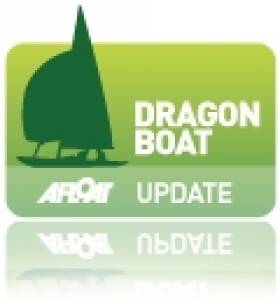Displaying items by tag: National Yacht Club
Royal St. George Entry Continues Dragon Championship Lead
#Dragon – Local sailors continue to lead the Dragon National Championships in Dun Laoghaire this morning. After six races sailed in the 13–boat fleet David Williams and Peter Bowring are three nett points clear of Kinsale's Cameron Good on 15 points as the event reaches its conclusion in gusty north–westerly conditions on Dublin Bay. Full results after six races at the National Yacht Club are below.
Dragon Nationals after six races sailed
Rank Fleet Boat SailNo Club Skipper Race 1 Race 2 Race 3 Race 4 Race 5 Race 6 Total Nett
1st PHANTOM IRL 176 R.STGYC BOWRING/WILLIAMS 2.0 (4.0) 1.0 4.0 4.0 1.0 16.0 12.0
2nd LITTLE FELLA IRL 211 KYC GOOD FURNEY KINGSTON 4.0 2.0 5.0 2.0 (6.0) 2.0 21.0 15.0
3rd CHIMAERA IRL 216 R.STGYC ANDREW CRAIG 3.0 (5.0) 3.0 3.0 3.0 3.0 20.0 15.0
4th BEAR ESP 71 SALCOMBE MARTIN PAYNE/ 1.0 6.0 4.0 (10.0) 1.0 4.0 26.0 16.0
5th JAGUAR IRL 201 R.STGYC MARTIN BYRNE 5.0 7.0 6.0 (13.0) 2.0 6.0 39.0 26.0
6th DUBLIN BAY IRL198 R.STGYC MAXWELL TRACY 12.0 3.0 7.0 1.0 (14.0 RET) 7.0 44.0 30.0
7th ZU IRL 214 R.SRGYC TIM PEARSON 6.0 1.0 8.0 (12.0) 7.0 8.0 42.0 30.0
8th BASILISK 515 ALDEBURGH PATRICK GIFFORD (14.0 RET) 14.0 DNC 2.0 5.0 5.0 12.0 52.0 38.0
9th DIVA 210 RIYC R.GOODBODY 8.0 (11.0) 9.0 8.0 8.0 5.0 49.0 38.0
10th TENACIOUS IRL 157 KYC ANTHONY O.NEILL 9.0 8.0 (12.0) 6.0 9.0 9.0 53.0 41.0
11th DECISION IRL195 R.STGYC J.MASON 7.0 10.0 10.0 7.0 10.0 (13.0) 57.0 44.0
12th ZinZan 127 RIYC TIM CARPENTER 10.0 9.0 (13.0) 11.0 11.0 11.0 65.0 52.0
13th AMSTAD GBR 585 R.STGYC RONAN MURPHY 11.0 12.0 11.0 9.0 (14.0 RET) 10.0 67.0 53.0
Phantom Takes Early Lead at Dragon National Championships
#dragonnationals – After three races sailed at the Irish Dragon National Championships at Dun Laoghaire, local Royal St. George yacht Phantom skippered by David Williams leads a 13–boat fleet. Four points adrift in a three way tie for second is Spanish yacht Bear steered by Paignton's Martin Payne, Kinsale's Little Fella sailed by Cameron Good and Andrew Craig's Chimaera of the Royal St. George YC. Racing continues today on Dublin Bay in moderate to light westerlies.
PROVISIONAL RESULTS IRISH DRAGON CHAMPIONSHIPS
1st PHANTOM IRL 176 R.STGYC BOWRING/WILLIAMS 2.0 4.0 1.0 7.0 7.0
2nd BEAR ESP 71 SALCOMBE MARTIN PAYNE/ 1.0 6.0 4.0 11.0 11.0
3rd LITTLE FELLA IRL 211 KYC GOOD FURNEY KINGSTON 4.0 2.0 5.0 11.0 11.0
4th CHIMAERA IRL 216 R.STGYC ANDREW CRAIG 3.0 5.0 3.0 11.0 11.0
5th ZU IRL 214 R.SRGYC TIM PEARSON 6.0 1.0 8.0 15.0 15.0
6th JAGUAR IRL 201 R.STGYC MARTIN BYRNE 5.0 7.0 6.0 18.0 18.0
7th DUBLIN BAY IRL198 R.STGYC MAXWELL TRACY 12.0 3.0 7.0 22.0 22.0
8th DECISION IRL195 R.STGYC J.MASON 7.0 10.0 10.0 27.0 27.0
9th DIVA 210 RIYC R.GOODBODY 8.0 11.0 9.0 28.0 28.0
10th TENACIOUS IRL 157 KYC ANTHONY O.NEILL 9.0 8.0 12.0 29.0 29.0
11th BASILISK 515 ALDEBURGH PATRICK GIFFORD 14.0 RET 14.0 DNC 2.0 30.0 30.0
12th ZinZan 127 RIYC TIM CARPENTER 10.0 9.0 13.0 32.0 32.0
13th AMSTAD GBR 585 R.STGYC RONAN MURPHY 11.0 12.0 11.0 34.0 34.0
#dlharbour – Hostile questions were asked in the Dail on Wednesday by local TD Richard Boyd Barrett on the proposed development of Dun Laoghaire Harbour as a cruise liner port. They were deflected in ministerial replies about legislation currently being drafted, and the two possible viable ways forward for the harbour's administration. But the underlying pace is accelerating towards a resolution of the future of this unique example of Victorian design, engineering and construction. W M Nixon finds that, in recent days and weeks, his views on the possible uses of this magnificent artificial harbour have undergone considerable change.
Embarrassment is a powerful stimulant for change. Change of attitude, change in ways in behaving, change in ways of looking at things, change to entrenched ways of thinking. I was hugely embarrassed by something seen in Dun Laoghaire nine days ago. And within seconds, there came a complete epiphany, with the sudden awareness that an entrenched attitude towards the development of Dun Laoghaire as a cruise liner port had turned through about 140 degrees.
It made for the complete 180 degrees, as the first 40 degrees of the turn had already been achieved a couple of weeks previously, while spending two completely absorbing if mentally exhausting hours with the maverick Alistair Rumball and his team at the Irish National Sailing School beside the inner recesses of Dun Laoghaire's inner harbour, which is still called the Coal Harbour even though it's very many years since anyone offloaded any lumps of the black gold there.
Be that as it may, as we parted we were shooting the breeze about the proposed development of Dun Laoghaire as a cruise liner port, which has been top of the local agenda since the end of March, and handily gave us one of our choicer April Fool's Day stories here on Afloat.ie - it proved so effective we had to add a health warning.
When a story provides you with something like that, you develop a certain affection for it. So while Alistair and I agreed that that the absolute dream solution for Dun Laoghaire Harbour would be a top-of-the-line government-funded National Monument Preservation Scheme, with the entire place given over exclusively to recreation afloat and ashore, and no commercial shipping of any significant size whatsoever allowed about the place, we knew it was pie in the sky.
"How on earth would they really pay for it?" he asked. "This place is huge, it costs a fortune to run and maintain. A cruise liner berth offers the best and most compact method of providing a worthwhile income stream. And as we in our sailing school – being a commercial operation – have to be rigorous in observing harbour regulations and keeping clear of the established in-harbour shipping lanes, we know that you can continue to sail small boats in large areas of the harbour without any undue sense of space restrictions".
Subsequently, I've been spending some time around Cork Harbour, where circumstances are so different from Dublin Bay that, unlikely as it may seem, you end up feeling sorry for the sailors of south Dublin. For while Cork is almost embarrassed by its riches in natural amenities for sailing, and it's all in a large and attractive harbour where marinas can be put down almost anywhere with no more than a floating breakwater to provide the necessary minimum of shelter, Dublin Bay by contrast is a hugely deprived area in terms of natural waterfront facilities for sailing, yet any attempts to provide man-made shoreline amenities for boats and sailors are dogged with local opposition every inch of the way.

Around Cork Harbour, it only needs a floating breakwater and, hey presto, you've suddenly got a marina - as seen here at Monkstown. Photo: W M Nixon
Thoughts of this struggle, and how things change, emerged again for various reasons in Dun Laoghaire nine days ago, at the reception in Irish Lights HQ to launch the Great Lighthouses Tourism Initiative. Time was when our many fine lighthouses were places of mystery, and permission to visit took quite a bit of arranging if it could be managed at all. But my word, times have changed. In this electronic age, there are those who wonder if we need all our lighthouses. Yet Irish Lights is legally obliged to maintain them, and the built structures around them.
So Yvonne Shields, the CEO of Irish Lights, whom we'd describe as very switched on and extremely bright were we not talking of the top executive in a lights organisation, unveiled this sensible scheme whereby twelve of our greatest lighthouses are being transformed into stations on a tourist trail, while continuing as working lighthouses.
As the greatest and most monumental lighthouses on land tend to be on rugged headlands in remote areas, in the eyes of Brussels they're in peripheral areas deserving special aid. So there's €2 million of Eurodosh going into this project, which sees what had become increasing liabilities being transformed into tourist resources. And if we're going to be sniffy about that, let's face it: the kind of tourist who'll want to visit a remote lighthouse will not be the kind of tourist who would keep you well clear of Temple Bar.
So the old grey matter was churning briskly away on the business of seeing lighthouses in a new way as we headed home past the Coal Harbour, and there it was: The Embarrassment. For this was the evening at the end of the day when the majestic and rather handsome cruise liner Queen Mary 2 was anchored off Dun Laoghaire in a near gale from the southwest which had delayed the morning's arrangements to ferry passengers ashore in the ship's own tenders to the special landing pontoon installed by the Harbour Company in the inner harbour.
By this time, they were trying to return on board, waiting patiently in a queue which ran the length of the inner pier and more as the two ship's tenders bustled the mile and a half plus out to the ship, yet still more buses turned up to disgorge more passengers, such that for a while the long length of the queue seemed to stay persistently the same.
Perhaps it's because we Irish don't do queuing that I found the entire thing acutely embarrassing to behold. And it wasn't even as if it was raining, which it well could have been. Nevertheless it struck me as being a Third World sort of scenario. Yet obviously these people were keen to visit Dun Laoghaire – most of the thousands of passengers on board had elected to go ashore.

This just won't do at all – images of Third World destinations came to mind on seeing the passengers from the Queen Mary 3 queuing in the Coal Harbour in Dun Laoghaire to get back out to their ship anchored in the bay. Photo: W M Nixon
So the epiphany came with the essential flashing great light. If we're going to have cruise liners calling at Dun Laoghaire, boomed this disembodied voice, then let's do it properly and provide them with a proper berth. Otherwise, don't have them about the place at all. But please, please – no more buzzing in and out in little tenders in this Irish climate, and no more queuing on a comfortless pier. It's an affront to our best traditions of hospitality.
This sudden firing-up with all the zeal of the recent convert (for until then, I'd wanted Dun Laoghaire to stay exactly as it is, and damn the expense) resulted in my being right into the dragon's den four days later. It was meant to be a short and businesslike meeting with Gerry Dunne, the CEO of Dun Laoghaire Harbour Company, to discuss the Cruise Liner Berth Proposals. But so many ideas were flying around that we ran well over time.
Please be assured, though, that I did my best to represent the needs of the boat-owning and sailing community while accepting that since Stena Sealink withdrew from running a ferry service from Dun Laoghaire to Holyhead, something very serious indeed needs to be done to pay for the maintenance of the harbour.
We have to remember that, among Ireland's main sailing centres, Cork and Kinsale are blessed with such good natural harbours that any marinas located in either harbour do not need fixed breakwaters. As for Bangor Marina on Belfast Lough, it may need a very substantial solid breakwater on its north side, but otherwise - thanks to being located in a bay - three of its four sides are naturally sheltered. But Dun Laoghaire is badly done by – it's so totally an artificial harbour in an exposed location that three of its four sides are protected by large man-made breakwaters, and while they are constructed in monumental style, continuous monitoring and maintenance is essential.
This is costly, but it would become even more so were standards allowed to slip for even a year or two. Even with the present high standards, there can be underlying wear and tear which in time needs major capital expenditure, and according to one recent report, hidden erosion on the most exposed section of the East Pier may eventually need up to €5 million for a proper remedial job.
As it is, the current basic running costs of the harbour are between €2 and €2.5 million a year. Were it kept as a purely recreational harbour and general public amenity, this figure could perhaps be slightly reduced. Yet the Dun Laoghaire recreational boating market still could not withstand paying the full amount out of its own resources and expected annual expenditure, so the shortfall would have to be made up by Government subvention.
But would the sailing and boating people of Dun Laoghaire really like to feel that they're beholden to taxpayers throughout Ireland for their continuing enjoyment of this wonderful amenity at affordable prices? There's something unpleasantly artificial about the idea of such an arrangement, whereas a harbour which is providing a modest but genuine profit is something which has a much healthier feel to it.
Surely if a way can be found of generating a worthwhile income stream without unduly distorting the traditional functioning of the harbour, then that idea should at the very least be actively explored, and recreational boating groups should be prepared to reach out towards compromises in the knowledge that, in turn, such arrangements would make the Harbour Company more accountable to all.
However, local representative Richard Boyd Barrett TD of the People Before Profit party, and Chair of Dun Laoghaire Save Our Seafront Group, sees it differently, and he has called for "a major campaign of people power against the planned cruise berth, and to protect the future of the harbour as a public amenity". His three main objections to a cruise berth plan are "(1) That the cost and financing of the project at €18 million means that the Harbour Company will have to borrow using its existing assets, where no proper business case has been produced. This puts the very future of the harbour at risk. (2) The entire plan has been hatched by an unelected board of the Harbour Company, Council Executives, and local business people who ran a sham of a public consultation over the two weeks of the Easter Holidays, and (3) The scale of the luxury liners at 300 metres long and 59 metres high will dwarf the harbour and reduce public access and public enjoyment of the most intact Victorian harbour in Britain and Ireland".
So with a Harbour Company which is government-owned, yet is charged with maximizing the economic benefit and exploiting the commercial opportunities provided by Dun Laoghaire Harbour, clearly there is something of a divide between the two sides. In fact, "light years apart" just about sums it up.
Nevertheless, politics being the art of the possible, it has to be possible to bring people together sufficiently to see that perhaps a proper sympathetically-designed cruise liner berth might indeed be the answer. After all, although it was built between 1817 and 1842 purely as a harbour of refuge for sailing ships with no thought of any interaction between sea and land, it very quickly became a ferry port for cross-channel steamships. At the height of this activity, with frequent roll-on roll-off ferries and their unpleasant shoreside traffic dominating the waterfront, Dun Laoghaire had lost much of its charm.
For the life of me I can't see that the much more limited shoreside traffic generated by the visits of cruise liners in the summer months can be seen as being anything like as obnoxious as the previous waves of road and rail traffic for the ferries, which was readily tolerated, and helped to keep the place going for 180 years.
And in any case, with the end of the ferry services, Dun Laoghaire definitely lacks purpose. In the Irish climate, it is very difficult to maintain a sense of vitality around a harbour which is purely devoted to personal recreation, whether afloat and ashore. It could be argued that, regardless of the economic benefits, it would be good for the mental spirit and communal well-being of Dun Laoghaire to be a cruise liner port of call, as a cruise liner strikes a neat balance between work and play. Like it or not, all work and no play may make Jack a dull boy, but all play and no work makes him mad.
But even if we accept that the shoreside traffic will be much less than it was with the regular ferries even if there is a cruise liner in port every other day, that is only part of the equation. How does the town itself shape up as a desirable cruise liner destination?
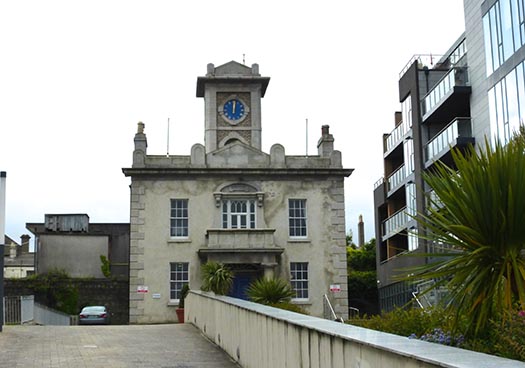
The Harbour Lodge is symbolic of today's Dun Laoghaire, a classical building from an earlier age, but now enclosed by modernity. Photo: W M Nixon
When we get down to the nitty gritty like this, Gerry Dunne is in his element. He's an affable guy, and good company, but I wouldn't like to get into a row with him, as there's steel underneath it all. So in the sedate setting of Harbour Lodge – which he cheerfully admits his opponents and friends have nick-named "Mussolini's Palace" – he's just the man to fight off the brickbats and work his way towards several objectives. But although he actually lives in Dun Laoghaire within walking distance of his office, he's not really into boat and water sports, yet that's no drawback, as personal preferences definitely don't come into it at all as he plans the way ahead.
He makes no bones about admitting that his attitude is strongly commercial. Before taking over the reins at Dun Laoghaire Harbour Company, he was Commercial Director at RTE, a job description which boggles the mind. Before that, he honed his skills in the UK, working for several large Irish food companies. If that gives you a vision of ditzy little artisan cheeses selling in agreeable country shops, then perish the thought – the big Irish food industries provide as tough a business environment as you could imagine.

The many moods of Gerry Dunne.Toughened by a varied and demanding career in business and marketing, he has brought a fresh mind to the problems of making Dun Laoghaire harbour economically viable. Photos: W M Nixon
He joined the Harbour Company in 2009, when talk of Stena's withdrawal was already in the wind. So he got Dun Laoghaire moving towards the cruise liner market in a small way, with the miniature 53-passenger Quest in 2011. Finding Quest an in-harbour berth was no problem, and she provided invaluable information on what Dun Laoghaire can provide as a USP for discerning cruise liner passengers. For Quest's rather specialist group, it was the easy access to the Wicklow Hills and particularly Mount Ussher Gardens, and they definitely didn't want to have to travel through Dublin City to get there.

The mini liner Quest – seen here in the Arctic - began the programme of attracting cruise ships to Dun Laoghaire in 2011
So far so good, but Gerry Dunne really struck gold when he started going to the cruise liner fairs in America and Europe. Gradually he built up a useful network, and again he struck gold when he got a report on the potential attractions of Dun Laoghaire from the Vice President (Itineraries) of one of the biggest American cruise liner conglomerates. Asked to sum up in one word the attraction of the Dun Laoghaire for visitors coming in from sea, her answer was: "Serenity".
We've become accustomed to Venice being talked of as The Most Serene Republic - The Serenissima. But it makes you sit up and take notice to hear of Dun Laoghaire being so described by a tough American businesswoman. Yet that's the impression the waterfront area, with its combination of the old yacht clubs, the station, the Town Hall and the Royal Marine Hotel, apparently makes on seaborn visitors from cruise liners, even if their liners are at present anchored outside the harbour and they have to be ferried in to land by ship's tenders. It seems they can blank out the less attractive buildings, and are left with the abiding impression of relaxed elegance with an easygoing way of life.
This takes a bit of getting used to, as it's so much at variance with the perception in Ireland of Dun Laoghaire as a place where they'd argue over anything and everything all the time, while just up the street there's the real problem of the dreary array of boarded-up shops. But like it or lump it, here it is folks – the reality is the yacht clubs and other other historically significant and stylish buildings of the Dun Laoghaire waterfront area – including the pleasantly under-stated Victorian residential terraces - are the town's greatest tourist asset.
Quite what some of the more senior members of the yacht clubs will make of that we can only guess, but the word is that the clubs have indicated that they'll be prepared to welcome some cruiser liner guests to their premises at pre-arranged times. So perhaps we should see the cruise liners as no more than extra-super super yachts......And there's no doubt that many rugged sailing folk from Dun Laoghaire are themselves only too happy to tootle off on a cruise liner when the peak of the sailing season is over.
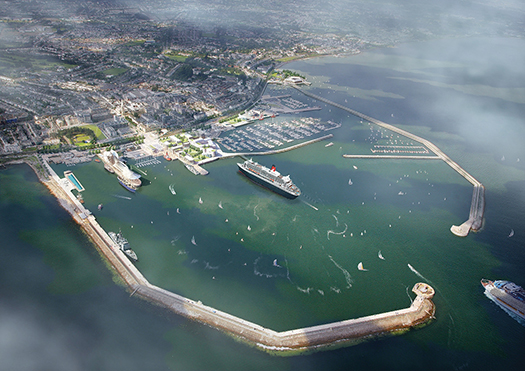
The artist's impression was just that – an artist's impression. If the new berth goes ahead, cruise liners will actually have their sterns towards the town.
But what is the reality if the new berth is agreed? Well, you can forget about your artist's impressions showing a liner facing the town. Space will be restricted, so the liners will come in stern first, thereby enabling them to make an elegant departure for the benefit of crowds down the end of the piers, which could become a popular occurrence.
The new liner pier will be as short as possible, though it will have an underpass for small craft, while the bows of the ships themselves will be held in place by dolphins, as was the HSS ferry. If you think that getting into this berth will involve impossibly ticklish manoeuvring, consider this recent photo of the three Cunard Queens up close and friendly in Southampton, and note that there's no lack of small craft nipping about among them.
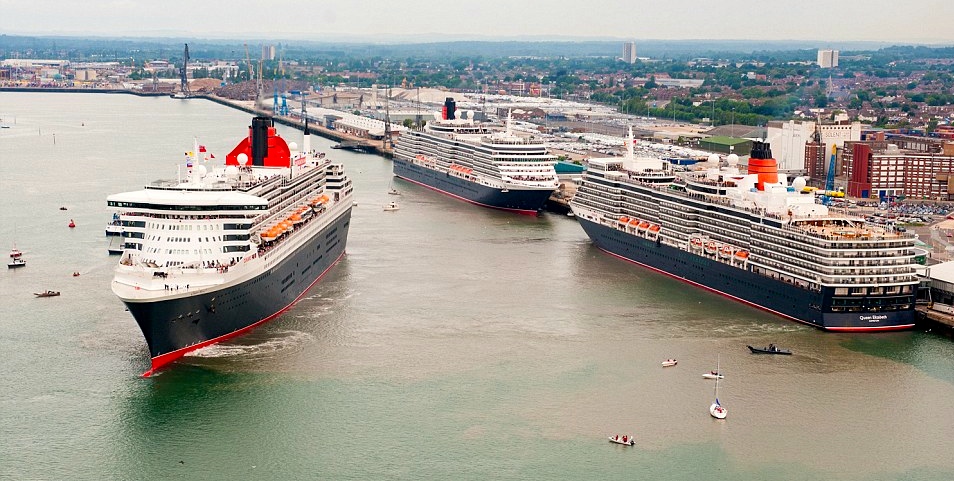 The three Cunarders can manoeuvre unaided at close quarters even with several small craft nipping about their heels, as seen here in Southampton
The three Cunarders can manoeuvre unaided at close quarters even with several small craft nipping about their heels, as seen here in Southampton
One of the other drawbacks about the current setup, with the ships anchoring off and people disembarking in the Coal Harbour, is that there's very little space for buses to move about, but the present waterfront marshalling yard left behind by the exit of Sealink will greatly relieve that problem if the new berth is built. At the moment, it is planned that passengers will walk the short length of the pier to reach their buses, but my own feeling is that the pier should be made a bit wider with a turning circle in order that passengers may board their buses almost directly from the ship, for we're not talking long distance athletes here.
That said, those who are fitter can come and go as they please, with the town within easy reach, whereas being anchored off can cause cabin fever. In other words, if Dun Laoghaire is going to have a cruise liner berth, let it be done properly – half measures involving long walks to buses just won't do, but equally for those who do walk, the town must feel accessible and welcoming.
As to the amount of space the ship will take up in the harbour, that will vary from ship to ship, but some are indeed enormous. And their wind-deflecting presence will certainly add an extra interest to in-harbour dinghy racing. As for the interest of the in-harbour racing for the visitors on the ship, that in turn will all be part of Dun Laoghaire's colourful charm, for which their ship will provide a grandstand view.
In line with that, we should remember that the leading in-harbour class, the historic Water Wags, have only just returned from showing themselves off at Morbihan Sailing week in France. Thus they'll scarcely be unduly bothered about providing a source of fascination for passengers on cruise liners, some of whom will probably be former dinghy racers themselves.
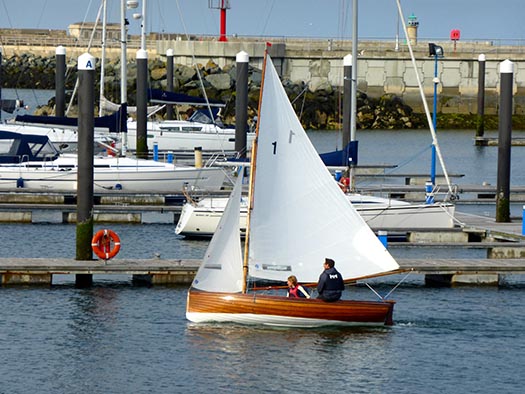
The Water Wags find it easy to sail freely within Dun Laoghaire Marina on their way out to race in the main harbour, so their only problem with a cruise liner berthed in mid-harbour will be the effect it has on wind flow. Photo: W M Nixon
But what the in-harbour dinghy racers are already becoming happily accustomed to is the newly-emptied eastern half of the harbour, with space now provided where boats used to moor. And this area will not be at risk from maneuvering cruise liners – there's not the depth for them. Finally, as to the height or otherwise of the ships in relation to other structures in Dun Laoghaire, I think we've been righteously indignant about this on a mistaken premise – since the new library was pushed into place, all bets about skyline heights and an elegant relationship with other waterfront buildings are clearly off.
So if the sailing and boating community can be more accepting of the cruise liners which will ultimately provide a real source of income to maintain the harbour which makes their activities possible, what can they expect in return?
They're in a strong negotiating position. After all, the Harbour Company's research has shown it is the comfortable presence of the yacht clubs which underpins this vision of serenity which is Dun Laoghaire's most appealing attraction for the kind of people who enjoy the cruise liner experience. So it's very much in the Harbour Company's interest to keep the clubs in good health.
By today's standards, the Royal Irish YC is thriving, thanks in no small part to its location within the marina against whose creation, ironically, the club fought tooth and nail. But the other three clubs – the Royal St George, the National, and the Dun Laoghaire MYC – are blighted by the limited and relatively unsheltered pontoon berthing at their clubhouses.
It may well be – and I'm only guessing – that the Marina Company's agreement with the Harbour Company includes a clause that these three clubs are not allowed to have their own adjacent marinas. But if such a clause exists, then it should be deleted for the greater good of the harbour and the vitality of the waterfront in general, and the three clubs should be facilitated in providing 150-boat marinas – with proper breakwaters for the George and National - in front of each clubhouse.
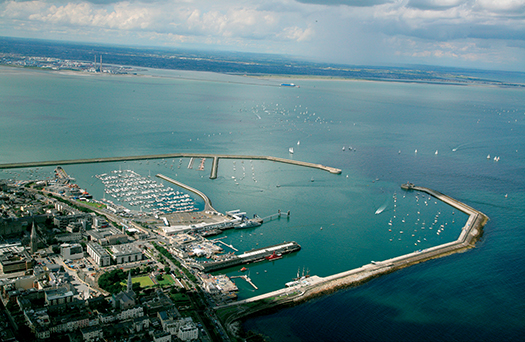
Dun Laoghaire from the southeast. If the new cruise liner berth is installed at mid-harbour, a longterm plan could be the installation of breakwaters in front of the Royal St George YC and the National YC in the foreground to shelter two new 150-boat marinas, as the location of the Royal Irish YC within the main marina gives it an unfair advantage in providing facilities for its members.
As to how Dun Laoghaire town can benefit, that's another matter altogether. The much stronger income and improved employment going through the Harbour Company will undoubtedly be a tangible good, though how seasonal it will be – with liners expected only between April and October – remains to be seen.
But personal expenditure by cruise liner passengers in the town is an imponderable. In fact, some cruise liners in the popular sunshine destinations are notorious for disembarking guests who feel that they made their total investment with the purchase of the ticket back home, so they don't plan to spend any more.
The historic little Venetian city-port of Dubrovnik on the Adriatic – which doesn't have a proper liner port – recently banned cruise liners from coming anywhere near the place, as their thousands of passengers made the narrow streets very uncomfortably crammed at peak times, yet the average expenditure ashore in Dubrovnik by each cruise liner passenger was precisely €6. There's food for thought. But we will of course get a better class of cruise liner passenger in Dun Laoghaire...
ISORA Sailors Set Sail for Isle of Man Offshore Weekend
#isora – No sooner is last night's DBSC racing over than some round–the–cans regulars are venturing outside the Bay this evening on a two–race ISORA weekend, with the Isle of Man as the focus. As David O'Brien reports in this morning's Irish Times Sailing Column the overall leader and defending champion Ruth (Liam Shanahan) has claimed a five point lead going into tonight's fourth race that has attracted a bumper fleet of over 20 that sees the focus of Irish sailing heading offshore this weekend.
The first race is tonight's 60–mile race four in the ISORA series from Holyhead in North Wales to the Isle of Man followed on Sunday by race five's 100–miler from the Manx port to Dun Laoghaire starting early at 0630 hours.
Overall, Shanahan's J109 from the National Yacht Club (NYC) leads Adrian Lee's Cookson 50 Lee Overlay Partners of the Royal St. George YC. The Pwllheli–based J109, Mojito is third. J boats occupy four of the top six places after three races and this weekend's forecast may also play into J hands.
As of this morning, the course for each race is likely to be direct from start to finish with light winds on offer and upwind a lot of upwind sailing predicted. This year's Avery–Crest sponsored series has the added attraction of satellite tracking that plots each competitors course, giving an extra dimension for race followers.
#isora – The Race 3 of the ISORA Avery Crest Offshore Series was very special as it was the first time that an ISORA Race was to be recorded using Yellow Brick (YB) satellite trackers that featured on Afloat's home page live during the race from Dun Laoghaire to Holyhead on Saturday. This 'huge step' for ISORA was facilitated by the generous sponsorship of "Avery Crest Ski Chalets Meribel" writes Peter Ryan, Chairman ISORA. Overall results after three races are available to download below.
The sponsorship allowed ISORA to acquire YB trackers to be used in all their races in the future. The use of the trackers brings the challenges and progress of offshore racing "right into your sitting room". In the past the fleet headed off from the start line and disappeared over the horizon, out of sight and unfortunately, out of mind. Now with the superb quality product, YB Trackers, all the boats taking part can be tracked and their progress followed by those left behind. As part of this leading tracking system, people can now download the YB Tracking app and buy the entire ISORA 2015 series of races for €2.99. All races can be replayed and analysed after the race in the comfort of your own home.
Of the 18 entries for the race, 17 came to the start line where National YC Commodore, Larry Power, sent the fleet off direct towards Holyhead at 08.05. The weather forecast for the race was not good since the beginning of the week. Earlier in the week the race promised to be run with very strong winds. However, as the week developed, a window of opportunity opened in the forecast to allow nearly perfect conditions for the race. This window was to close by early Sunday morning when again strong southerly winds were expected on the Irish Sea. With this limited window of opportunity available, the Sailing Committee decided to shorten the course to go direct to Holyhead.
![]()
A screenshot of the ISORA fleet race trackers used for the first time in Saturday's race from Dun Laoghaire to Holyhead. Click here for more
At the start, the winds were North westerly 10-12 knots. The forecast showed that a hole of "no wind" would develop close to the Irish coast by mid-day and it was vital that the fleet made progress away from the land immediately after the start. The fleet, lead by the Adrian Lee's Cookson 50 "Lee Overlay", sped under spinnaker out of the bay towards Holyhead. With the tide turning north just after the start, the fleet were pushed north.
Soon into the race, there was little sign of the "hole" appearing and the fleet sped towards Holyhead with an ETA of 15.30 for most of the fleet. In the fleet there were five J109s. "Jedi", now sailed two-handed got into some spinnaker hoist difficulties are the start and fell to the rear of the fleet. "Wakey Wakey" also had problems at the start and also fell towards the rear. The remaining three J109s, "Ruth", "Mojito" and "Sgrech" commenced a battle for position that went on for nearly five hours with less than a boat length between the three.
Then the "Hole" arrived!! The fleet slowed down to a near halt. This was made worse by the significant "lop" on the sea, making progress very difficult. "Lee Overlay" who sped away from the fleet after the start, appeared to have sailed very north and probably around the hole. They make cracking progress sailing a most northerly course until due north of the Skerries. There they gybed into a strong foul tide but heading for the finish line in Holyhead.
The remainder of the fleet were caught in the "hole" and all progress stopped for approximately two hours. Two handed "Bam" and J109, "Ruth", were first to break and head off at speed towards Holyhead followed eventually by the fleet.
On the approach to Holyhead, many of the fleet underestimated the strength of the south going tide cross the mouth of the harbour and, while only slightly below the course to the end of the breakwater, got trapped in the tide and made very little progress toward the end of the pier end. This "faux pas" allowed the main fleet to regain contact with the leading part of the fleet.
"Lee Overlay" had an easy passage, crossing the finish line at Holyhead at 14.26 and turned on the line to head back to Dun Laoghaire. The next boat to arrive was "Bam" at 17.00. The last boat to cross the finish Line, manned by Dawn Russell of Holyhead sailing Club, was "Lady Rowena" at 19.33. At this stage "Lee Overlay" had nearly arrived back to its berth in Dun Laoghaire marina.
Adrian Lee's " Lee Overlay" took an easy overall and Class 1 win on his first cross channel in ISORA since his return to racing in the Irish Sea. David Simpson's Swan "Albireo" took Class 2 and Silver Class. The downwind racing did not suit the J's with "Ruth" taking 3rd place overall behind "Bam".
The next two races involve a weekend of offshore racing with a race from Holyhead to Douglas on Friday evening, 22nd May, followed by a second race starting early Sunday morning 23rd May from Douglas to Dun Laoghaire. These races can be followed by downloading the YB tracking app or on the tracker viewer on the ISORA website www.isora.org .
These are exciting times for ISORA. The use of the YB trackers is a critical cog in the progress and development of offshore racing in these waters.
#isora – Racing under the burgee of the National Yacht Club, the third race in the Irish Sea Offshore Racing Association (ISORA) 2015 series will start from Scotsman's Bay on the south side of Dublin Bay early on Saturday morning. The Irish offshore fleet is fitted with yellowbrick trackers for the 60–mile race across the Irish Sea from Dun Laoghaire to Holyhead, an important warm up for next month's Dun Laoghaire to Dingle race, also from the NYC.
The reigning ISORA champion Ruth skippered by Liam Shanahan was the winner of April's first race coastal race of the season, a fortnight ago. The NYC J–109 took a six minute win on corrected time from the Irish National Sailing Club Reflex 38 Lynx skippered by Kenneth Rumball. Third in that race was the Arklow Sailing Club J122, Aquelina.
ISORA Race three sailing instructions are downloadable below.
Time-lapse of National Yacht Club (NYC) Summer Lift–In of Yachts
#lift–in – A Time-lapse video by Declan Tonge of the morning's lift-in at the National Yacht Club (NYC) Dun Laoghaire last weekend, squashing 3.5 hours into just under 3 mins.
A mobile crane comes to the club at the start of the sailing season, and lifts all the boats off their cradles & trailers back into the sea so they can go back onto their harbour moorings for sailing over the Summer months.
The clip was shot between 07:10 - 10:45 on Saturday morning and made up of 4292 individual photos taken at 3-4 sec intervals.
Baltimore Sailing Club's Fionn Lyden 11th at Laser Europa Cup
#lasereuropacup – Afloat's sailor of the month for March, Fionn Lyden from West Cork was the top Irish performer at the massive qualifcation series of the Laser Europa cup Regatta at Malcesine on Lake Garda ended on Saturday with two races for the 600 competitors – claiming a record for an Olympic class event.
Baltimore Sailing Club's Lyden finished narrowly missed a top ten finish overall, placing 11th in his 100–boat Laser standard fleet. The National Yacht Club's Finn Lynch was 23rd, Daragh O'Sullivan from Kinsale Yacht Club was 27th.
In the battle for the final podium places, Alessio Spadoni ITA took the overall lead in the Laser event (100 entries) with Giovanni Coccoluto ITA in second. In the men's Radial (213 entries) Matthieu De By BEL leads from Dominik Perkovic CRO and in the women (85 entries) Silvia Zennaro ITA leads from Gintare Scheidt LTU.
Full results are here.
#isora – With the first ISORA coastal race in just two weeks time, (25th April with races from Dun Laoghaire and Pwllheli) offshore sailors gather next Friday for an ISORA Pre–Season Talk & Reception at the National Yacht Club. ISORA Commodore Peter Ryan is extending the invitation to all Afloat.ie readers.
Ed Hill of North Sails will talk about offshore sailing and tactics and ISORA's own Liam Coyne will talk about "Planning for a two handed race". There will be tips on sail changes, dealing with practical problems in two handed racing and safety concerns.
The talk will be hled next Friday at the NYC at 19.30 hours
#vdlr –With an entry list the envy of regatta organisers everywhere, July's Volvo Dun Laoghaire Regatta (VDLR) has received a massive entry of 302 boats so far with three months to run to its first gun. Over 63 different yacht clubs are represented in a fleet that will split into 20 different sailing classes for the four day extravaganza at the Irish east coast port. Enthusiastic insiders say the tenth anniversary of the event may yet hit its all time high of 500 boats by July 9 but a more modest reckoning of 400 plus will certainly match the 2013 and 2011 editions of Ireland's largest sailing event.
Run by the four waterfront clubs of the DMYC, RIYC, NYC and RSt.GYC's this year's event is under the stewardship of former Fastnet race winner Tim Goodbody and Dragon Edinburgh Cup winner Martin Byrne. An overview of the biennial event was published by Afloat.ie last weekend in WM Nixon's blog here.
The bulk of entries come from the Dublin Bay area itself but there is also strong interest from along the east coast from Greystones, Arklow, Howth and Skerries. Most encouragingly, the event is proving to be a draw for boats from further afield too with entries from across the Irish Sea some of the first to sign up.
As previoulsy reported by Afloat.ie, the following events are confirmed as part of the event:
Royal Dee Yacht Club Irish Sea Offshore Championship
J109 Irish National Championship
RS Elite Irish National Championship
Beneteau First 21 Irish Championship
Wayfarer Irish National Championship
GP 14 Leinster Championship
J24 Leinster Championship
In encouraging news for dinghy sailing (that has separately been given a shot in the arm this year by local DBSC organisers), it looks like VDLR will also see a lift for centreboard classes. 2015 will see a record number of dinghies classes participating. In addition to the regular one designs such as the Mermaid, Flying 15, Squib, Fireball, IDRA 14 – organisers are welcoming the GP14, Wayfarer, RS200/RS400, Laser classes to the regatta with their own starts.
It is the first visit to the Regatta for the GP14 fleet and organisers are very much looking forward to welcoming the class, all of whom will be from visiting clubs from around the country. An expected entry of 40 GP14's are expected and they will be hosting their Leinster Championships as part of the Regatta.
The Wayfarers are returning after running their a successful UK Nationals within the 2011 Regatta and this year they will be running their Irish Nationals, an expected entry of 20 visiting Wayfarers are expected.
Big entries are also expected from both the Laser and RS fleets. It still remians to be seen if the PY class can muster sufficient numbers.
VDLR had issues recently with its online payment. To accommodate anyone who has had difficulties it has extended the early bird discounted entry fee offer deadline to Friday, April 17th.


























